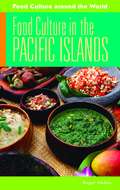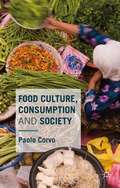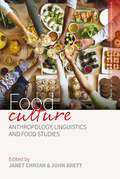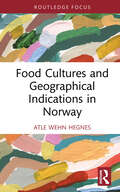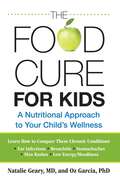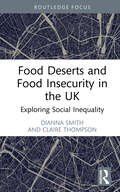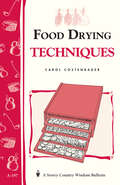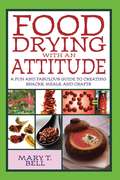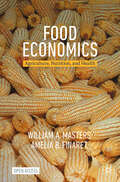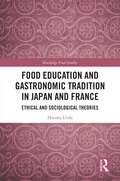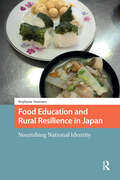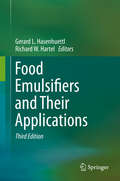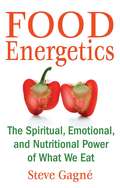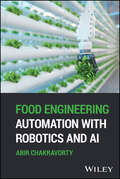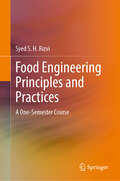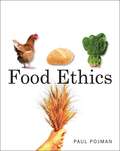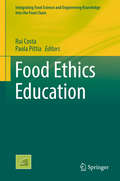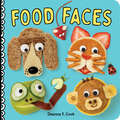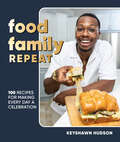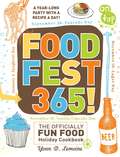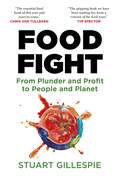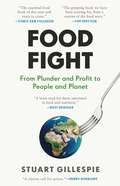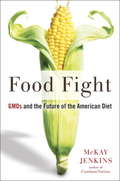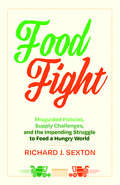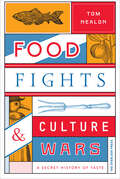- Table View
- List View
Food Culture in the Pacific Islands
by Roger HadenWritten for students, general readers, and foodies alike, Haden's (gastronomy, history of food and drink, U. of Adelaide, Australia) text provides a solid introduction to the food culture of the 22 diverse Pacific Ocean countries located on some 12,000 islands spread across roughly one-third of the earth's surface. A general introduction is followed by an historical overview of the region, description of major foods and ingredients, cooking techniques and technologies, typical meals, regional specialties, traditional dining practices versus eating out, special foods for special occasions, and diet and health issues. In addition to a map of the region, a timeline of key historical and food-related events, a glossary of terms, and a list of online, video/film, and print resources, the text includes a sampling of traditional recipes. Illustrated with b&w photographs. Annotation ©2009 Book News, Inc., Portland, OR (booknews.com)
Food Culture: Anthropology, Linguistics and Food Studies (Research Methods for Anthropological Studies of Food and Nutrition #2)
by John Brett Janet ChrzanThis volume offers a comprehensive guide to methods used in the sociocultural, linguistic and historical research of food use. This volume is unique in offering food-related research methods from multiple academic disciplines, and includes methods that bridge disciplines to provide a thorough review of best practices. In each chapter, a case study from the author's own work is to illustrate why the methods were adopted in that particular case along with abundant additional resources to further develop and explore the methods.
Food Cultures and Geographical Indications in Norway (Routledge Focus on Environment and Sustainability)
by Atle Wehn HegnesThis book analyses the implementation and challenges of using Geographical Indications in Norway. Adapting the modern and global system of Geographical Indications (GIs) to food cultures is a recurring challenge. This text uses Norway as a case study to describe, understand, and explain the socio-cultural adaptation of GIs. The empirical analysis shows that administrators, producers, consultants, and others make a significant effort to adapt the scheme to Norwegian food culture and the food culture to the scheme. Through the development and use of a new conceptual framework, the book continues to show how adaptations occurred and their influence on the development of the Norwegian food culture. The author also reflects upon the status of Norwegian GIs in emerging food cultural contexts related to sustainable and technology change. In summary, this book exhibits the connection between modern global legislative arrangements and traditional local products, providing a springboard for further research on cultural adaptation work of GIs in established and future global food cultures. This book will be of interest to researchers, policymakers, and students in agri-food studies, sociology of food and agriculture, agricultural and rural development, and cultural studies.
Food Cure for Kids: A Nutritional Approach to Your Child's Wellness
by Oz Garcia Natalie Geary Carol Mann AgencyA must-have resource for any parent whose child has chronic ear infections, bronchitis, stomach aches, or skin rashes. This eye-opening book will finally offer parents the results they've been searching for--without yet another trip to the doctor's office.
Food Deserts and Food Insecurity in the UK: Exploring Social Inequality (Routledge Focus on Environment and Sustainability)
by Claire Thompson Dianna SmithThis book examines the social inequalities relating to food insecurity in the UK, as well as drawing parallels with the US. Access to food in the UK, and especially access to healthy food, is a constant source of worry for many in this wealthy country. Crises, such as the COVID-19 pandemic, have coincided with a steep rise in the cost of living, meaning household food insecurity has become a reality for many more households. This book introduces a new framework to examine the many influences on local-level food inequalities, whether they result from individual circumstances or where a person lives. The framework will allow researchers new to the field to consider the many influences on food security, and to support emerging research around different sub-topics of food access and food security. Providing a thorough background to two key concepts, food deserts and food insecurity, the book documents the transition from area-based framing of food resources, to approaches which focus on household food poverty and the rise of food banks. The book invites researchers to acknowledge and explore the ever changing range of place-based factors that shape experiences of food insecurity: from transport and employment to rural isolation and local politics. By proposing a new framework for food insecurity research and by drawing on real-world examples, this book will support academic and applied researchers as they work to understand and mitigate the impacts of food insecurity in local communities. This book will be of great interest to students and scholars of food and nutrition security, public health, and sociology. It will also appeal to food policy professionals and policymakers who are working to address social inequalities and improve access to healthy and nutritious food for all.
Food Drying Techniques: Storey's Country Wisdom Bulletin A-197 (Storey Country Wisdom Bulletin Ser.)
by Carol W. CostenbaderSince 1973, Storey's Country Wisdom Bulletins have offered practical, hands-on instructions designed to help readers master dozens of country living skills quickly and easily. There are now more than 170 titles in this series, and their remarkable popularity reflects the common desire of country and city dwellers alike to cultivate personal independence in everyday life.
Food Drying with an Attitude: A Fun and Fabulous Guide to Creating Snacks, Meals, and Crafts
by Mary T. BellThis ultimate food drying resource has something for everyone: vegetarians, natural and raw food enthusiasts, hunters, fishermen, gourmet cooks, gardeners, farmers, hikers, and even fast food junkies. With more than thirty years of food drying experience, Mary T. Bell offers straightforward and practical instructions for drying everything from yogurt to sauerkraut to blue cheese, without ignoring traditional favorites such as jerky, mushrooms, and bananas. Throughout, Bell offers nutritional tips and highlights the time-, space-, and money-saving benefits of food dehydrating. Also included are descriptions of how various food dehydrators work to give readers a better understanding of the tools of the craft. Food Drying with an Attitude gives readers the recipes, instructions, and inspiration they need to get the most out of their home food dehydrators.
Food Economics: Agriculture, Nutrition, and Health (Palgrave Studies in Agricultural Economics and Food Policy)
by William A. Masters Amelia B. FinaretFood Economics provides a unified introduction to the economics of agricultural production, business decisions, consumer behavior, and the government policies that shape our food system. This open access textbook begins with economic principles derived using graphical techniques to explain and predict observed prices, quantities, and other outcomes as a result of individual choices influenced by market structure and public policies. The second half of the book explores available data globally and for the US, covering a wide range of questions in agriculture and economic development, food marketing, and consumption. Food Economics and its accompanying online resources are designed for advanced undergraduate or introductory graduate courses in agriculture, food, and nutrition policy. The book covers the standard diagrams taught in principles-level courses, with concrete examples and practical insights regarding food production, consumption, and trade. Online resources include data sources, and course materials, including slides, exercises, exams, and answer keys.
Food Education and Gastronomic Tradition in Japan and France: Ethical and Sociological Theories (Routledge Food Studies)
by Haruka UedaDrawing on ethical and sociological theories of food, this book presents a new approach to food education that moves beyond nutrition-centred education. Food education has gained increasing scientific and political importance in many countries as a promising way to change contemporary eating. However, many practices fail to address two epistemological obstacles regarding its very components – ‘food’ and ‘education’. Food has largely been thought of from a nutritionistic viewpoint alone and the ethical issues over children’s freedom of choice and well-being have been absent. This book resolves these problems by applying ethical and sociological theories of food and analysing food education in two pioneering countries: Japan and France. The book focuses on taste education and gastronomy as two key concepts which have great potential to positively impact food education. Taste education is a promising alternative to nutrition-centred pedagogy which foregrounds the experience and pleasure of eating food, creating an environment for taste sensibility and food curiosity. From taste education, the picture can be broadened to examine the role and impact of gastronomy in food education. Examining the cultural traditions of France and Japan reveals how gastronomy can impact eating habits and food cultures and how these criteria should be an intrinsic part of food education. The book concludes by constructing an integrative theory for food education that moves beyond nutrition-centred education for the benefit of one’s well-being. This book will greatly interest students, scholars, policymakers and educators working on food education, food-related issues at the intersection between nutritional and social sciences, and ‘gastronomes’ searching for a pedagogical guide for developing their capabilities to eat in a more humanistic way.
Food Education and Rural Resilience in Japan: Nourishing National Identity (Consumption and Sustainability in Asia)
by Stephanie AssmannFood education initiatives exist worldwide, but Japan remains unique with its food education law known as shokuiku. The country’s impressive health metrics — high life expectancies, low obesity, and affordable health care — often lead observers to praise this approach. This book presents a more nuanced analysis. First, it challenges the assumption that food education is wholly a “good thing” by exposing underlying power mechanisms. Through food diagrams, food fairs, and school lunch programs, government ministries promote both nationalism and traditional gender roles. Second, it explores how food education operates in Japan’s rural regions, where educators champion resilience and food self-sufficiency to alleviate depopulation and economic decline. This emphasis on local food persisted even in the aftermath of the 2011 Fukushima nuclear disaster. Using Foucault’s concept of governmentality, historical contextualization, and extensive fieldwork in rural Japan, this study reveals the complex political agenda driving food education in a non-Western society.
Food Emulsifiers and Their Applications
by Richard W. Hartel Gerard L. HasenhuettlEmulsifiers, also known as surfactants, are often added to processed foods to improve stability, texture, or shelf life. These additives are regulated by national agencies, such as the FDA, or multi-national authorities, such as the EEC or WHO. The amphiphilic molecules function by assisting the dispersion of mutually insoluble phases and stabilizing the resulting colloids, emulsions, and foams. Emulsifiers can interact with other food components such as carbohydrates, proteins, water, and ions to produce complexes and mesophases. These interactions may enhance or disrupt structures and affect functional properties of finished foods. In dairy processing, small molecule emulsifiers may displace dairy proteins from oil/water and air/water interfaces, which affects stability and properties of the foams and emulsions. In baked products, emulsifiers contribute to secondary functionalities, such as dough strengthening and anti-staling. Synthetic food emulsifiers suffer from the stigma of chemical names on a product’s ingredient statement. Modern consumers are seeking products that are “all natural.” Fortunately, there are a number of natural ingredients that are surface-active, such as lecithin, milk proteins, and some protein-containing hydrocolloids. Mayonnaise, for example, is stabilized by egg yolk. This book can serve as both a guide for professionals in the food industry to provide an understanding of emulsifier functionality, and a stimulus for further innovation. Students of food science will find this to be a valuable resource.
Food Energetics: The Spiritual, Emotional, and Nutritional Power of What We Eat
by Steve GagnéExplains how food imparts a living wisdom that is separate from the science of nutrient values• Offers an approach to diet from the perspective of ancient peoples, who understood how the energetic qualities of food affect both physical and spiritual health• Includes a comprehensive catalog of the energetic properties of myriad foods--from chicken, beef, and potatoes to garlic, avocados, zucchini, and grapefruitFood is more than simply fuel. It imparts a living wisdom that is beyond the science and mechanics of calories, grams, and nutrient values. Ancient peoples, through their relationships with the plants and animals providing their food, understood that their food conveyed the unique energetic qualities of its source, such as swiftness from wild deer and groundedness from root vegetables. With the rise of agribusiness and industrial food production, people have become disconnected from the sources of their food and are no longer able to register the subtle rhythms, harmony, and energies that food can convey. This separation has thrown the basic human-food relationship out of balance--to the detriment of human consciousness. In Food Energetics, Steve Gagné shows how to revitalize our connection to food and remedy our physical and psychic imbalances with the wisdom of food energetics. He provides a comprehensive catalog of foods and their corresponding energetic properties and explains how each food affects us at the deepest spiritual level. By demonstrating how to plan meals that incorporate both dominant and compliant foods, he shows how to provide truly healthy cuisine that nourishes the body and the soul.
Food Engineering Automation with Robotics and AI
by Abir ChakravortyRevolutionize food manufacturing with the latest in automating technology Virtually every area of industry has been transformed by robotics and AI, which have automated production and increased efficiency in myriad ways. Until recently, food manufacturing was an exception to the trend. At present, however, the food manufacturing industry is in the process of a transformation which will see automation deliver the same levels of productivity and uniformity that have revolutionized other sectors of the economy. Food Engineering Automation with Robotics and AI is a comprehensive introduction to the areas of intersection between cutting-edge technologies and food manufacturing. Beginning with an overview of the basic principles of food engineering, the book then details applications of robotics and AI in this field, along with the way automation is integrated at every stage of food production. The structure of the book seamlessly blends theory and practice to maximize reader capacity to put its lessons into motion. Food Engineering Automation with Robotics and AI readers will also find: Content aligning with several UN Sustainable Development Goals, including Zero Hunger; Industry, Innovation, and Infrastructure; and Responsible Consumption and ProductionReal-world case studies throughout to show automating technologies revolutionizing food productionA consistent focus on sustainable food engineering, with attention to resource conservation, waste reduction, environmental impact mitigation, and more Food Engineering Automation with Robotics and AI is ideal for the growing, global market for food automation technologies in the coming years.
Food Engineering Principles and Practices: A One-Semester Course
by Syed S. RizviThis textbook is designed for a one-semester course on Food Engineering, and it offers a concise, in-depth and integrated introduction to the fundamental engineering and physicochemical principles and practices of utility in food processing and manufacturing operations. The textbook includes topics mandated by the Institute of Food Technologists for accreditation of Food Science curricula and helps prepare the students better for taking advance courses related to unit operations in food manufacturing. It is also relevant for Food Process Engineering courses, containing materials that most instructors can cover in three semester hours of instruction. In the first three chapters, readers will find an overview of the basic knowledge of physics and chemistry and an introduction to the engineering language needed to eliminate confusion going forward. In the following chapters, the author covers the main concepts of food thermodynamics, heat transfer–radiation in foodmaterials, mass transfer and fluid dynamics in food, along with real-life examples and exercises to help students relate better to the topics. The author also gives a brief introduction to the main mathematical and analytical concepts required in food engineering.This textbook equips readers to understand a diversity of food engineering related topics and each chapter is enriched with practical examples and Check Your Understanding sections, as well as several problems. The textbook is aimed at undergraduate food science students in their first required introductory food engineering course, but practitioners involved in designing, optimizing, and managing the processing of food products will also find it a useful account.
Food Ethics
by Paul PojmanThis text provides an introduction to the complex issues arising from the question, "How should we eat?" Food Ethics has become one of the central fields within Environmental Ethics, developing to the point where it can be considered its own field. Three of the early issues at the core of 1960's and 70's environmentalism, animal rights, population and consumption dynamics, and toxic pollutants, form the center of modern food ethics debates, but new questions have also arisen, responding to developments in both food technologies and the globalization of land use.
Food Ethics Education
by Rui Costa Paola PittiaThe book is divided in 3 sections, each containing several chapters: Section 1 includes chapters that identify and discuss several ethical issues along the food chain, with particular detail of issues in the food industry and in consumer behavior; Section 2 includes chapters that present the basis of a code of conduct in the food profession as well as the description of existing codes of conduct of food industry and food scientist professionals, including ethics of publishing, and also ethics in risk communication; Section 3 includes chapters based on case studies with examples of teaching approaches currently used in teaching food ethics, easy to implement and already tested and confirmed as successful examples that engage students in this topic. Although professional ethics in food supply chain is claimed as an essential topic to be addressed in any degree program, few higher education institutions that currently include a module on ethics in their study programs. In g eneral, it is argued that ethics is a topic addressed along the curriculum and embedded in the contents of the modules. However, ethics, for its importance, needs a different teaching and educational approach, and this book achieves that. .
Food Faces: A Board Book
by Deanna F. CookFood has never been more fun for little ones! In this delightful board book, children encounter friendly animal faces, all made out of favorite foods, including an owl (with kiwi eyes), a monkey (banana bread muffin), a butterfly (with fruit wings), and more.
Food Family Repeat: Recipes for making every day a celebration
by Keyshawn HudsonThe debut cookbook from social media star, Chef Keysh, featuring 100 family favorites.Since embarking on his public cooking journey in 2021, Keyshawn Hudson has charmed his loyal following across social media platforms with his charisma and a whole lot of heart. Known for his catchphrases, like "Save this one for later" and "Cook it with a smile", Keysh's infectious warmth is captured in every piece of content he posts, and his fans eat up every bit.Keysh is not formally trained, but he credits the influence of his Jamaican roots with sparking his love of cooking. These days, he's found his true element, sharing his joy with others and inspiring them to get into the kitchen. This book will showcase Keysh's incredible talent for creating craveable and doable family meals-whether that be for a busy weeknight or a larger gathering with loved ones. With dishes like Sweet Potato Cornbread, Oxtail Tacos, and Buffalo-Lemon Pepper Wings, Chef Keysh always has the right recipe to pair with the moment.
Food Fest 365!
by Yvan D. Lemoine"[Mr. Lemoine's] desserts . . . verge on spectacular. " --The New York TimesWhip up a quick dessert to celebrate Coconut Torte Day on March 13! Stock up on vermouth to celebrate Dry Martini Day on June 19! Up for fried seafood? October 2 is National Fried Scallops Day!With this fabulously fun cookbook,everyday is a holiday--that is, a nationalfoodholiday!In this book, acclaimed chef and Food Network competitor Yvan D. Lemoine shares recipes with a trademark exuberance that invites you to the party! You'll be treated to interesting food trivia alongside easy-to-follow instructions for how to make such mouthwatering goodies as Salted Caramel Popcorn (for Popcorn Day, January 19), Almond Madeleines (for Almond Day, February 16), Spinach and Artichoke Dip (for Artichoke Heart Day, March 16), andmanymore for each month that follows. Packed with a refreshing, random mix of recipes associated with each day of the year and festive full-color photos throughout, this delightfully uncommon cookbook is sure to tempt the tastebuds of foodies and free-spirits alike!
Food Fight: From Plunder and Profit to People and Planet
by Stuart GillespieUsing decades of research and insight gathered from around the world, health and nutrition expert Stuart Gillespie reimagines our global food system, plotting a way forward for a sustainable, equitable, and healthy food future Food is life, but our food system is killing us. Designed in a different century for a different purpose—to mass-produce cheap calories to prevent famine—it’s now generating obesity and ill-health and driving the climate crisis. We need to transform it into one that can nourish all eight billion of us and the planet we live on. In Food Fight, Stuart Gillespie shares the insights he’s gleaned over a forty-year career in food, nutrition, and health, revealing how the global food system we once relied upon for nutrition has warped into the very thing making us sick. Many of us are now simultaneously overweight and undernourished. From its origins in colonial plunder through to the past few decades of neo-liberalism, our food system now lies in the tight grip of a handful of powerful transnational corporations that are playing for profit at any cost—aided by governments who let them get away with it. With his eye trained on solutions within our grasp, Gillespie also celebrates success stories from around the world, driven by remarkable citizens, social movements, policy makers, and politicians. These case studies offer hope that, by organizing, sharing, and learning, we can build a better food future for ourselves and for our children. Both unflinching exposé and revolutionary call to arms, Food Fight shines a light inside the black box of politics and power before mapping a way toward a new system that gives us hope for a future of global health and justice.
Food Fight: From Plunder and Profit to People and Planet
by Stuart Gillespie"Scholarly, literate and deeply moving, this isn't just a good read, it's an essential reference for anyone hoping to understand the food system, why it's broken and how we might imagine fixing it."—Chris Van Tulleken, author of Ultra-Processed PeopleFood is life but our food system is killing us. Designed in a different century for a different purpose—to mass-produce cheap calories to prevent famine—it&’s now generating obesity, ill-health and premature death. We need to transform it, into one that is capable of nourishing all eight billion of us and the planet we live on. In Food Fight, Stuart Gillespie reveals how the food system we once relied upon for global nutrition has warped into the very thing making us sick. From its origins in colonial plunder, through the last few decades of neoliberalism, the system now lies in the tight grip of a handful of powerful transnationals whose playbook is geared to profit at any cost. Both unflinching exposé and revolutionary call to arms, Food Fight shines a light inside the black box of politics and power and, crucially, maps a way towards a new system that gives us hope for a future of global health and justice.
Food Fight: GMOs and the Future of the American Diet
by Mckay JenkinsAre GMOs really that bad? A prominent environmental journalist takes a fresh look at what they actually mean for our food system and for us. In the past two decades, GMOs have come to dominate the American diet. Advocates hail them as the future of food, an enhanced method of crop breeding that can help feed an ever-increasing global population and adapt to a rapidly changing environment. Critics, meanwhile, call for their banishment, insisting GMOs were designed by overeager scientists and greedy corporations to bolster an industrial food system that forces us to rely on cheap, unhealthy, processed food so they can turn an easy profit. In response, health-conscious brands such as Trader Joe’s and Whole Foods have started boasting that they are “GMO-free,” and companies like Monsanto have become villains in the eyes of average consumers.Where can we turn for the truth? Are GMOs an astounding scientific breakthrough destined to end world hunger? Or are they simply a way for giant companies to control a problematic food system? Environmental writer McKay Jenkins traveled across the country to answer these questions and discovered that the GMO controversy is more complicated than meets the eye. He interviewed dozens of people on all sides of the debate—scientists hoping to engineer new crops that could provide nutrients to people in the developing world, Hawaiian papaya farmers who credit GMOs with saving their livelihoods, and local farmers in Maryland who are redefining what it means to be “sustainable.” The result is a comprehensive, nuanced examination of the state of our food system and a much-needed guide for consumers to help them make more informed choices about what to eat for their next meal. From the Hardcover edition.
Food Fight: Misguided Policies, Supply Challenges, and the Impending Struggle to Feed a Hungry World
by Richard J. SextonSociety's most basic challenge is arguably to produce and distribute enough food for its citizens. In 2023, 733 million people faced hunger and 2.3 billion were moderately or severely food insecure. Feeding a growing world population is becoming more difficult in the face of climate change, pest resistance to traditional treatments, and misguided government policies that limit how much food ends up on our plates. Policies to support biofuels, organic agriculture, local foods, and small farms and to oppose genetically modified foods all reduce food production on existing land. This leads to higher food prices, increased carbon emissions, and less natural habitat as cropland expands. Food Fight documents the challenges to adequately feeding the world in the twenty-first century and illustrates the ways in which contemporary food policies in the United States, Europe, and beyond imperil food security. Richard J. Sexton provides a window into the world of modern agriculture and food supply chains. He separates the wheat from the chaff to distinguish policies that will limit, or expand, the global food supply, and he explains how we can construct a food system that forestalls future hunger and environmental degradation.
Food Fights & Culture Wars: A Secret History of Taste
by Tom NealonIn this eclectic book of food history, Tom Nealon takes on such overlooked themes as carp and the Crusades, brown sauce and Byron, and chillies and cannibalism, and suggests that hunger and taste are the twin forces that secretly defined the course of civilization. Through war and plague, revolution and migration, people have always had to eat. What and how they ate provoked culinary upheaval around the world as ingredients were traded and fought over, and populations desperately walked the line between satiety and starvation. Parallel to the history books, a second, more obscure history was also being recorded in the cookbooks of the time, which charted the evolution of meals and the transmission of ingredients around the world. Food Fights and Culture Wars: A Secret History of Taste explores the mysteries at the intersection of food and society, and attempts to make sense of the curious area between fact and fiction. Beautifully illustrated with material from the collection of the British Library, this wide-ranging book addresses some of the fascinating, forgotten stories behind everyday dishes and processes. Among many conspiracies and controversies, the author meditates on the connections between the French Revolution and table settings, food thickness and colonialism, and lemonade and the Black Plague.
